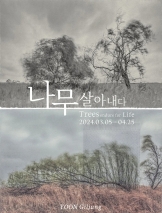전 시 명: 윤길중 개인전 _나무, 살아내다_ Trees endure for Life
전 시 기 간: 2024.03.05(화) – 04.25(목)
관 람 시 간: 월-금 10:00–18:00, 토 11:00-18:00 (*일요일 및 공휴일 휴관)
전 시 장 소: 경기도 성남시 분당구 정자일로 166 SPG Dream Bldg. 8층 아트스페이스 J
아트스페이스 J는 2013년부터 형도의 갯벌에 염분으로 인해 깊게 뿌리를 내리지 못하고 살아가는 나무들의 처연하고도 강인한 생명력을 카메라에 담아오고 있는 사진가 윤길중의 개인전 <나무, 살아내다>를 개최한다. 인간의 욕심이 만들어낸 생태 교란이 가져온 나무들의 기이한 모습에서 삶의 의지를 발견했던 작가는 COVID-19 시기를 겪으며 나무들에게 한발 더 다가가 위안을 건네는 작업들을 새로이 선보인다. 25점의 <나무, 살아내다> 작품을 만나볼 수 있는 본 전시의 오프닝 당일에는 전시 제목과 동명의 사진집 출간을 기념하는 출판기념회도 함께 진행될 예정이다.
나무, 살아내다
나무들은 뿌리를 내린 땅과 바람이 떠도는 하늘 사이에서 꼼짝없이 자신들의 운명을 개척하며 살아간다. 이동의 자유가 없는 나무들은 어느 곳에 뿌리를 내리느냐에 따라 삶이 달라진다. 큰 나무 밑에 뿌리를 내린 나무는 큰 나무가 떨어뜨린 나뭇잎으로 비옥해진 토양 덕분에 어릴 때는 잘 자란다. 하지만 자라면서 큰 나무에 치여 죽거나 큰 나무를 피해 자신의 몸을 비틀어야 살아남을 수 있다. 힘이 비등한 나무들은 가까이 붙어 있는 방향으로 가지를 뻗지 않고 반대쪽으로 가지를 키워나가는 걸 보면 나무들의 삶도 동물들이 살아가는 방식과 별반 다르지 않다는 걸 알 수 있다.
나무들은 자신의 뿌리가 견딜 수 있을 만큼만 몸집을 키운다고 한다. 그래서 웬만한 바람에도 잘 쓰러지지 않는다. 그런데 형도라는 섬에는 쓰러진 채 살아가는 나무들이 많다. 바다를 막아 시화호라는 인공호수를 만들면서 형도는 섬이 아니라 육지가 되었는데, 형도 갯벌에 복토를 하자 물을 좋아하는 버드나무들이 자연스레 군락을 이루었다. 버드나무들은 땅 밑에서 올라오는 염분으로 뿌리를 깊게 내리지 못해 바람을 견디지 못하고 넘어진 것이다. 뿌리를 드러낸 채 몸통은 옆으로 누워 있지만, 잔가지들은 하늘을 향해 살아가는 버드나무들, 죽음 대신 또 다른 삶을 택했다. 우리나라는 간척을 통해 땅을 넓히거나 물길을 막아 댐을 만드는 것이 생태계에 얼마나 지대한 영향을 줄 것인가에 대한 고민 없이 많은 개발이 이루어져 왔다. 그 속에서 살아가는 동식물들의 생태 교란은 우선순위에서 밀리고 개발이익이 최고의 가치 기준으로 작동되어온 것이다. 자연질서의 파괴는 돌고 돌아 부메랑으로 돌아온다는 사실은 이제 우리 눈에 잡힐 만큼 확연해지고 있다.
이번 시리즈 작업을 하면서 나무들과 대화를 참 많이 했다. ‘아무리 세찬 바람이 불어도 너는 이제 쓰러질 일이 없잖아!’ 쓰러진 채 살아가는 나무에게 내가 말을 걸면 ‘경쟁의 대열에서 한 발짝만 비켜나면 다른 세상이 보여.’라고 나무가 응수했다. 큰 수술을 받고 난 후라 그랬는지 나무들의 끈질긴 생명력이 나에게 큰 울림으로 다가와 한 꺼풀 꺾인 삶의 의지를 되살릴 수 있었다. 2013년부터 2년간 형도 버드나무 작업을 하면서 나무들에게서 위안만 받은 거 같아 빚진 마음이었는데, 7년이 지난 후 다시 작업할 때에는 촬영한 사진을 씨줄, 날줄로 직조를 하면서 나무들 상처 부위를 수없이 어루만졌다. 나무의 살아냄이 우리의 살아냄과 무관하지 않음을 알기에 형도 벌판에서 힘겹게 버티며 살아가는 나무들을 따뜻하게 보듬어주고 싶었다.
윤길중
Trees, endure for life
Under the vast sky, trees live in the spots where they have dropped their roots, carving out their own destiny. Trees, which cannot move about freely, live out different lives depending on where they take root. Imagine a tree dropping its roots under a larger one. It may grow well, initially, thanks to the soil enriched by fallen leaves; however, as this tree matures, it cannot compete against the larger tree and will eventually lose out or will end up with crooked branches to avoid physical contact with the bigger tree. Similar-sized trees extend their branches in opposite directions rather than moving closer together. With all of this, we see that the lives of trees may not be so different from those of animals.
Trees grow only as large as their roots will support. As such, they don't fall over easily, even in the windiest conditions. However, on an island called Hyeongdo, the willow trees have fallen over yet retain life. When Sihwa Lake was artificially created by blocking the sea, Hyeongdo rose from the water. Water-loving willow trees naturally formed a colony on the covered Hyeongdo mudflats. However, due to the salt rising from the ground, these trees could not put down deep roots. Eventually, the trees began to fall over, unable to withstand the heavy winds. The willow trees, now lying on their sides with roots exposed and branches reaching toward the sky, chose a second life instead of death. Korea has carried out many such reclamation projects without giving the proper consideration for the significant ecological impact of artificially expanding its land or creating dams by blocking waterways. Conserving the ecology for the native plants and animals was not a priority, and only development profits became the highest value standard. We now see with our own eyes that, if we destroy the natural order, the harm will eventually return to us like a boomerang.
While working on this project, I had a lot of conversations with trees. “No matter how strong the wind blows, you will never fall!” I spoke to the trees and could hear the trees answer: “If you take just one step away from the ranks of competition, you will see a different world.” The persistent vitality of these trees resonated with me, particularly because I had just undergone major surgery. Watching the trees, I could revive my own will to live, which had been broken down with time. While working on the willow trees in Hyeongdo for two years, starting in 2013, I felt indebted to them, feeling as though I was the only one receiving comfort in this exchange. After seven years, I had the opportunity to work once again and I touched the wounds of the trees countless times while weaving the pictures I had taken with the weft and warp strings. Nnowing that the survival of trees is not irrelevant to our survival, I wanted to warmly care for the trees that struggled to survive in the fields of Hyeongdo.
YOON Giljung


